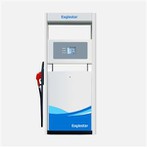The fuel dispenser should maintain a beautiful and tidy surface, and it needs to be wiped and waxed frequently to remove moisture in time to avoid rust. Regarding the cold north, before the severe winter, the internal parts of the tanker should be disassembled and washed, and maintained with a maintenance cover to avoid freezing and cracking of the parts caused by the accumulation of water inside the tanker.
When using the oil gun, avoid improper operations such as hitting the oil container with the main oil pipe of the oil gun, pressing the switch, etc. This operation may damage the root of the oil injection pipe and cause oil leakage. Check regularly and tighten the stop screw on the oil pipe to avoid loosening and damage to the root of the oil pipe. Always check the joints of the pipelines, whether the oil seals and gaskets of the various parts are leaking, whether there are air bubbles in the oiler, whether the electrical wiring is secure, and whether the ground connection is outstanding.
There is a wire in the rubber layer of the oil delivery hose of the tanker, and its two ends are separately connected to the hose joint to avoid the wire from being badly touched, broken or the oil gun is statically ignited. Always check the electrostatic performance between the oil gun and the dispenser during use. If you replace the oil hose, the wire must be stripped to fit the length and cleaned up, so that both ends are separated from the oil gun and the refueling machine body to maintain an outstanding conductive touch to ensure its ability to discharge static electricity.
When the solenoid valve of the fuel dispenser cannot be opened and the machine does not deliver oil, first check the control circuit part of the solenoid valve, such as whether the light valve board, relay board or main board is damaged, and whether the neutral line is connected properly, and then check the solenoid valve Its own shortcomings, such as whether the coil in the valve is open, whether the valve membrane hole is blocked, etc. Check the exhaust status of the exhaust pipe of the oil and gas separator under the power-on state. If the exhaust is not stopped, you can start to determine that it is the leakage defect of the tanker pipeline or the bottom valve.





